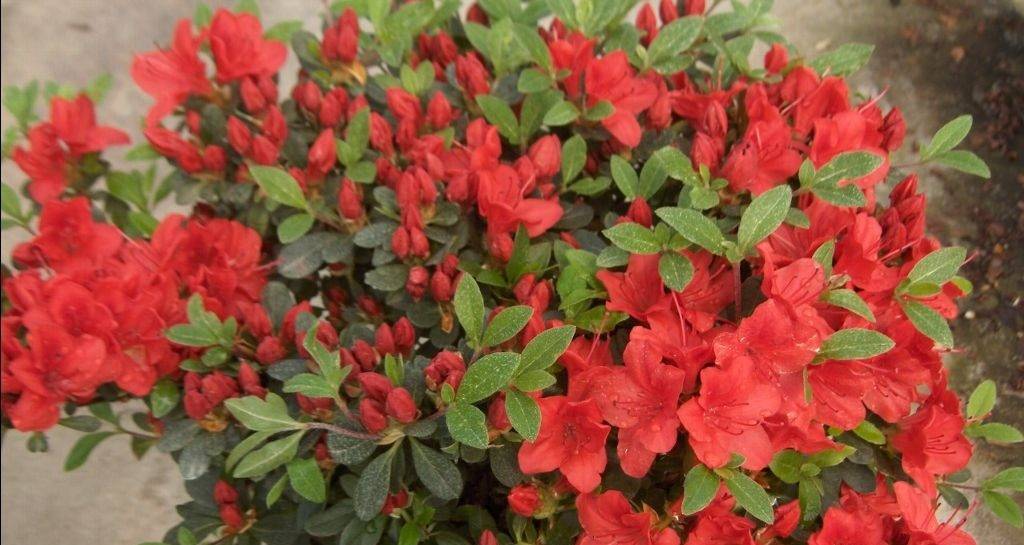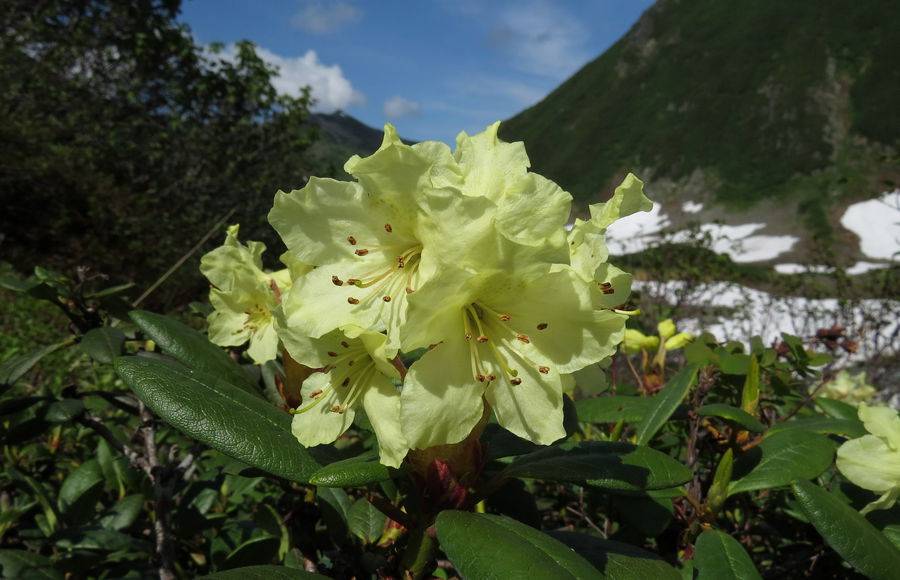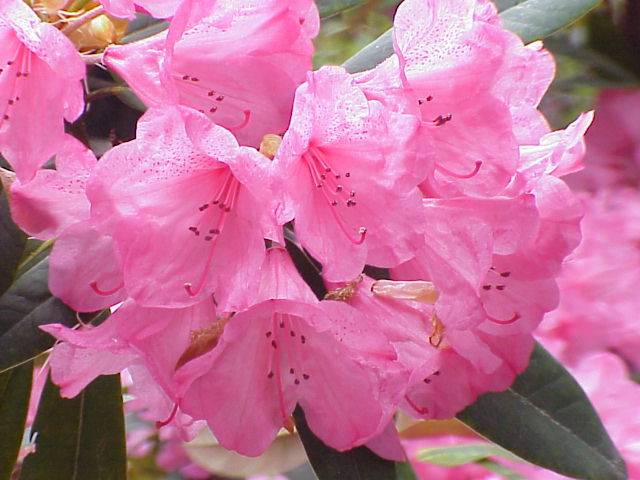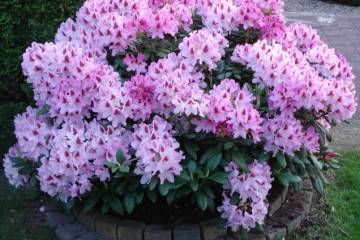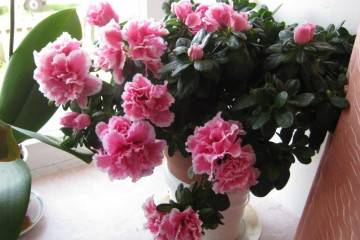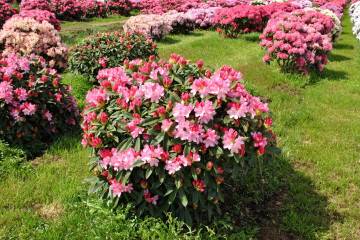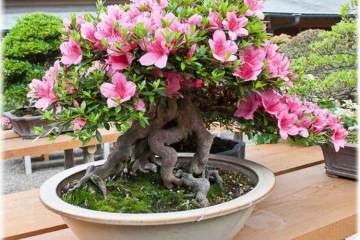Azalea and rhododendron are the same or different plants
Content:
Unusually beautiful and delicate flowers - azalea and rhododendron - are very similar to each other. In ancient times, magical properties were attributed to these flowers. Azalea will perfectly decorate a room, greenhouse, greenhouse, and rhododendron - a flower bed in a garden or park.
Azalea and rhododendron - is there a difference
Many novice growers are eager to find out how rhododendron differs from azalea. Both of these plants belong to the Ericaceae family and the Rhododendron genus. Its name is derived from two ancient Greek words: "rhodes" - "pink" and "dendron" - "tree". This genus includes more than 600 species of shrubs and small trees, which can be deciduous and evergreen.
The difference between these two colors is evident in the appearance and in the peculiarities of care. It is necessary to care for plants growing in open ground in a completely different way than for the inhabitants of closed ground.
Many growers call azalea all deciduous plant varieties of this species, and rhododendron - all evergreens. However, there are far more similarities than differences between them.
Common features:
- The shallow, fibrous root system consists of many compact adventitious roots.
- The similarity of the structure of leaves and flowers.
- They need the same conditions of detention.
Historical confusion
In ancient times, the word "rhododendron" was called oleanders. In 1853, this name was assigned to one and only species of this plant - rusty rhododendron. Some time later, several hundred species were included in the genus Rhododendron.
In the last century, some practicing gardeners have singled out a separate genus Azalea from the Heather family. But after a while, scientists confirmed that the differences between these two plants are not so great that there is a reason to divide them into two genera. Now the Azalea clan is disbanded.
In the XVIII-XIX centuries, they tried to bring azalea to Europe from India several times, but very often the flower died on the way. This attempt was first undertaken by the Dutch biologist Jacob Breinius, but to no avail. Finally, the English botanist Koners managed to bring the flower alive. At the beginning of the 19th century, breeders began to work on the development of cultivated varieties of azaleas. Most of them are derived from two types of rhododendron:
- Simsa (Indian azalea);
- Dull (Japanese azalea).
The most famous varieties:
- Stella Maris (Indian) - a small bush up to 1.5 m high. Terry flowers consist of white petals with crimson spots.
- Fridoline (Japanese) - the bush grows up to 80 cm in height. Large, up to 4.5 cm in diameter, bright red flowers bloom on it.
- Czardash is a light-loving shrub with large yellow flowers with 20 petals each. They are collected in inflorescences of 12-14 flowers.
- Azzurro is a hybrid variety, which is a tree with a height of 1.5 meters. It has dark green elongated leaves and purple petals with crimson spots.
Modern classification
Currently, all plants that were previously considered azaleas are assigned to the genus Rhododendron. Many cultivars were bred for cultivation in the room, garden, greenhouse. All of them are of great variety.
The genus Rhododendron includes many different species.They are divided into several groups: evergreen, semi-deciduous, deciduous. These species differ from each other in size, color of petals and foliage.
Evergreens:
- Caucasian rhododendron is a bush up to 1.5 m high covered with pinkish or yellowish flowers. The flowering period is from May to June. It is necessary to cover for the winter.
- Smirnova is a frost-resistant bush that grows up to 1 m. The flowers are pink or red.
- Golden is a creeping shrub covered with dark green leaves and wide open golden flowers.
- Short-fruited - the petals can be white, cream or pink. Blooms for 2-3 weeks. It grows quickly, feels great even in severe frosts.
- Carpathian (Kochi) - bright pink petals, stems no more than 50 cm in height. Flowering occurs in May and June.
- The largest - lives up to 100 years, withstands severe cold, blooms in June-July. White or pink petals are covered with orange dots.
- Katevbinsky is a mountain bush, the height of which reaches 3-4 meters. Its branches are covered with green leathery leaves. During the month (from mid-May to the second half of June), large purple or lilac flowers (up to 6 cm in diameter) bloom, collected in inflorescences of 15-20 pieces each. Resistant to frost, grows both in the shade and in a lit place.
Semi-deciduous (retain a little foliage on the crown):
- Pointed - grows slowly, blooms in spring, and sometimes also in autumn. Pink or lilac petals bloom.
- Daursky - flowers of five lilac, pink or purple petals bloom in spring for three weeks. In autumn, flowering is often repeated. It tolerates cold well.
- Ledebour is an incredibly tall (up to 3.5 m) tree covered with thin leaves, the upper part of which is olive in color, and the lower one is brown. Violet-pink flowers bloom in April for 14 days.
Deciduous:
- Kamchatsky - grows on the stony soil of the tundra, in the arctic climate. Its height never exceeds 35 cm. The flowers can be pink, purple or bright red.
- Canadian - purple petals about 3 cm long appear in May for 2 weeks. The bluish crown covers a tree up to 70 cm high.
- Japanese - the bush grows up to 2 meters in height. Green leaves turn reddish-yellow in autumn. Cream, pink, salmon, coral petals.
- Vaseya - in May, pale pink flowers open before the appearance of crimson leaves.
Endangered species of this plant are listed in the Red Book:
- Yellow is a deciduous shrub with greenish-gray leaves. The petals are yellow or orange. Blooms for 2-3 weeks in May. In the wild, it grows both in forests and mountains. In the Caucasus, it is called "mad brushwood" or "bitter tea".
- Schlippenbach is a deciduous tree. At the end of spring, along with the appearance of leaves, flowering begins. The petals are pale pink or speckled purple. By autumn, the foliage turns red-yellow.
- Fori is an evergreen tree up to 2.5 meters high. Flowers with cream or pink petals open in May-June.
There are also many varieties of hybrids of rhododendron and azalea.
How to distinguish azalea from rhododendron by appearance
The difference between azalea and rhododendron is manifested in many external features. If you look closely, you can see the difference.
How to distinguish azalea from rhododendron by eye:
- Azaleas have funnel-shaped flowers. Some species have single flowers, but most often they are collected in clusters of 2-6 pieces each. Rhododendron flowers are bell-shaped. They are collected in inflorescences or brushes, sometimes they are solitary. The flowers of both plants are quite large: their diameter can reach 20 cm.
- Rhododendrons grow outdoors. Azaleas prefer indoors.
- Azaleas are very small: they rarely grow taller than 30-50 cm. Most of the other rhododendrons are larger.
- The shape and size of the leaves of rhododendron are very diverse.Azalea leaves can have one of three shapes: lancet, ellipse, or egg. Their length does not exceed 4 cm.
- Azalea leaves can be covered on both sides with a thin soft fluff. Plants with smooth leaves are found. The leaves of the rhododendron are covered with small scales.
- Azalea has 5 stamens, rhododendron has more than 10, in some species 7–10.
- Azalea bushes very actively. Rhododendron grows slowly.
- Young twigs of azaleas are covered with thin brown or gray villi. Rhododendrons do not have this phenomenon.
Difference in azalea and rhododendron care
The main difference in caring for these plants is that azalea is traditionally considered an indoor or greenhouse flower, and rhododendron is a garden flower growing outdoors in the street.
Azalea grows at home, so it feels great when warm. It does not tolerate cold and dies if the temperature drops below -6 ° C. Most varieties of rhododendron can withstand temperatures down to 20-27 ° C. They need to be covered for the winter.
How to grow these flowers
A loose fibrous soil with high acidity is prepared. It is advisable to choose a heather soil. You can prepare the substrate yourself: 1 part sand + 1 part peat + 2 parts coniferous earth + 1 part humus.
Landing order:
- The earthen ball must be held in water, and then placed in a pot or pit. In this case, the root collar of the seedling must remain above the ground, otherwise the plant will die.
- Pour soil on top and tamp it lightly.
- Water liberally after planting. Then water every day for a month.
Both plants need to be repotted annually. Young ones need an annual transplant, old ones are transplanted every 2-3 years. Once a month, you need to feed the flowers with complex fertilizers.
Reproduction methods: cuttings, layering, dividing the bush, growing from seeds.
Fit and Care Difference:
- The azalea should be rooted 5–7 cm deep. For a miniature indoor flower, you will need a small pot, and for a garden flower, a pit up to 50 cm deep.
- Azalea bushes heavily, so you need to prune it regularly.
- When caring for garden flowers, you do not need to monitor the temperature and humidity conditions. Indoor azaleas are very demanding for these conditions. The soil in the pot should always be moist, but when watering, you should not let the drops fall on the petals and leaves. Watering the land should be alternated with adding water to the pan. After 5 hours, the excess water is drained off. Avoid excess and stagnant moisture.
- The ground under the rhododendron must not be loosened.
In landscape design, rhododendron is most often planted, while in greenhouses and rooms - azaleas. The first of them are much less whimsical to care for than the second. The difference between these two colors is negligible and only plays an important role in plant care.

